Olympus E-400 with Zuiko Digital 14-42mm f3.5-5.6 ED
-
-
Written by Gordon Laing
Olympus E-400 design and controls
| Support this site by shopping via these links |
| Support this site by shopping via these links |
The Olympus E-400 lays claim to being the smallest and lightest DSLR, and measuring 130x91x53mm with a body weight of just 375g, it’s certainly very compact. Seeing a photo of the E-400 by itself just doesn’t do it justice, so we’ve pictured it below alongside the Canon EOS 400D / Rebel XTi, a DSLR famous for being small, but which actually looks quite hefty next to the E-400. You can also see the E-400 demonstrated in our video tour.
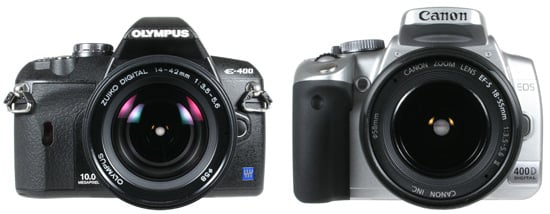 |
It’s also clear from the photos and video that Olympus has been inspired by classic 35mm film SLRs of the 80s, designing the E-400’s body with a retro style that’s bereft of the large grips you find on modern DSLRs – indeed there’s little grip to mention beyond a slightly raised surface on the right hand side.
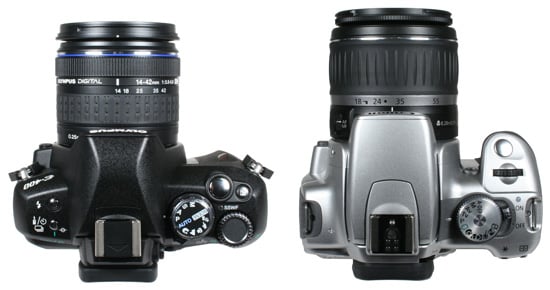 |
The combination of reduced dimensions and lack of apparent grip could sound alarm bells in terms of comfort and usability, but there’s thankfully little cause for concern. While there’s obviously less to wrap your fingers around, the E-400 can still be held comfortably and securely, and after only a few minutes you forget the absence of a modern grip. This shouldn’t come as too much of a surprise though, as this was the way all 35mm film SLRs were made for years with little or no complaint.
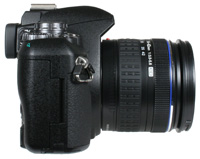 | |
The lack of a modern grip has also allowed the E-400 to avoid common criticisms levelled at the Canon 400D / XTi and other tiny DSLRs. After all, since there’s no grip, there’s no tight area between it and the lens barrel to pinch your fingers.
That said, it is quite an unusual design for a modern DSLR, so if you haven’t had any experience handling similarly-styled older 35mm cameras, we’d advise picking it up in person and trying it for size. As mentioned earlier though, you get used to the E-400’s shape pretty much straightaway, and thanks to carefully-placed rubber surfaces, it’s easy to enjoy a secure and comfortable hold on the body.
The E-400’s weight and price-point unsurprisingly result in a plastic shell, but it feels solid and well-constructed without any creaks or poor joins. In these respects it feels to a similar standard as Canon’s 400D / XTi.
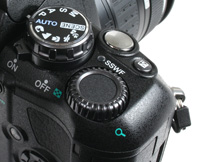 | |
The most important controls on the upper right surface share a similar layout to the earlier E-500. There’s a mode dial offering Auto, Program, Manual, Aperture and Shutter Priority modes, along with five popular scene presets and a dedicated Scene position which provides access to a further 14 presets via an on-screen menu. A rotary switch around the dial’s base powers the camera on and off.
To the right of the main mode dial is a single thumb dial, used to adjust the aperture, shutter speed, playback magnification or various menu options, while towards the front of the camera lie the shutter release and exposure compensation buttons. The upper left side is home to just two buttons controlling the drive mode and flash options.
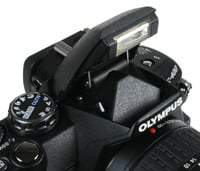 | |
The E-400 is equipped with a popup flash and a hotshoe which offers TTL Auto options with the optional FL-50, FL-36, FL-20, RF-11 and TF-22 lights, although does not support the FL-40 and there’s unsurprisingly no PC-sync port. The maximum flash sync is 1/180. Popup flash options include slow-sync, rear curtain and fill-in, along with a flash compensation scale and three settings for reduced power output.
Round the back there’s four buttons to the left side of the screen for image playback, image delete, accessing the main menu and switching the on-screen information. To the right of the screen are a traditional four button layout with an OK button in the middle for navigating and confirming options, along with an AE / AF lock button by the viewfinder and a programmable Function button which by default activates the depth-of-field preview.
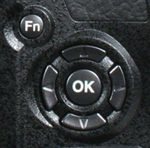 | |
Interestingly, while there’s essentially the same number of buttons on the back as the Canon 400D / XTi, the four direction controls don’t appear to offer instant access to popular settings such as the ISO, White Balance, Metering or AF modes. At first glance it appears you need to enter menus to adjust each of them, but thankfully Olympus has implemented the same control system as the E-500, where you select the option you want to adjust from the main info screen, then just press OK to select it; we’ll fully explain this in the Features section.
Olympus offers a PT-E03 underwater housing for the E-400 which is good to depths up to 40m.
Battery
and connectivity
The E-400’s powered by a slim PS-BLS1 1150mAh Lithium Ion battery pack and is supplied with a mains recharger (which handles international voltages using common figure-8 mains leads). We managed around 250 shots per charge under a variety of shooting conditions.
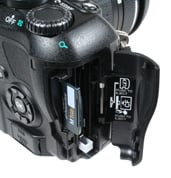 |
The E-400 can handle both xD and Compact Flash memory cards using two separate slots behind a door on the right side of its body, although you can’t record to both simultaneously. We realise that’s the kind of feature reserved for top of the range professional DSLRs, but it’d be nice to have the option on any camera with separate slots – if you’ve previously suffered from corrupt cards, the ability to record simultaneously to a pair for backup purposes can be most reassuring.
And finally, behind a small flap on the rear of the E-400 you’ll find a single port delivering both USB and TV connectivity; the E-400’s supplied with two different cables for use with this port.




